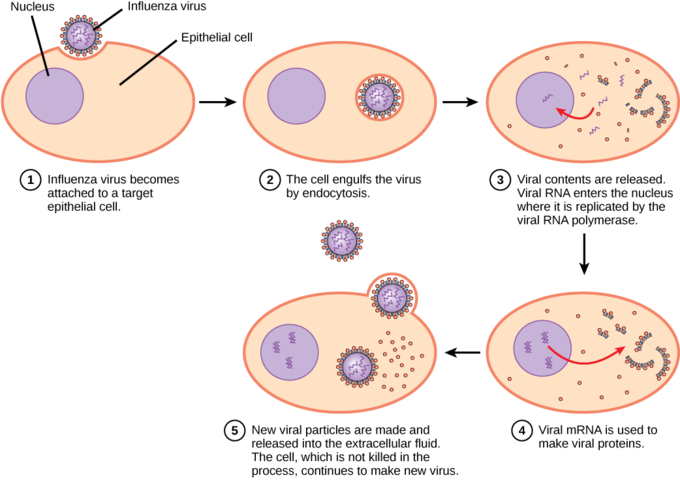
ВІРУСКА ЛАБА 12
.docxMeans chemoprophylaxis of viral diseases
Topic: Means chemoprophylaxis of viral diseases.
Task:
1. Classify and characterize antiviral drugs.
2. Develop a scheme the main stages of reproduction of viruses, which are antiviral drugs
Sources (guidelines):
1.Калініна О.С., Панікар І.І., Скибіцький В.Г. Ветеринарна вірусологія . м.Львів 2004р., 521 с.
2. Сюрин В.Н., Белоусова Р.В., Фомина Н.В. Диагностика вирусных болезней животных: Справочник. — М.: Агропромиздат, 1991. — 528 с.
1. Most of the antiviral drugs now available are designed to help deal with HIV, herpes viruses, the hepatitis B and C viruses, and influenza A and B viruses. Researchers are working to extend the range of antivirals to other families of pathogens.
Designing safe and effective antiviral drugs is difficult, because viruses use the host's cells to replicate. This makes it difficult to find targets for the drug that would interfere with the virus without also harming the host organism's cells. Moreover, the major difficulty in developing vaccines and anti-viral drugs is due to viral variation.
The emergence of antivirals is the product of a greatly expanded knowledge of the genetic and molecular function of organisms, allowing biomedical researchers to understand the structure and function of viruses, major advances in the techniques for finding new drugs, and the pressure placed on the medical profession to deal with the human immunodeficiency virus (HIV), the cause of acquired immunodeficiency syndrome (AIDS).
The first experimental antivirals were developed in the 1960s, mostly to deal with herpes viruses, and were found using traditional trial-and-error drug discovery methods. Researchers grew cultures of cells and infected them with the target virus. They then introduced into the cultures chemicals which they thought might inhibit viral activity, and observed whether the level of virus in the cultures rose or fell. Chemicals that seemed to have an effect were selected for closer study.
This was a very time-consuming, hit-or-miss procedure, and in the absence of a good knowledge of how the target virus worked, it was not efficient in discovering effective antivirals which had few side effects. Only in the 1980s, when the full genetic sequences of viruses began to be unraveled, did researchers begin to learn how viruses worked in detail, and exactly what chemicals were needed to thwart their reproductive cycle.
The main clinical classification of these drugs is based on their primary use. According to this criterion, the following groups are distinguished:
-
Anti-herpetic drugs - have the greatest activity against the viruses of the shingles Acyclovir - the best antiviral agent for the treatment of herpes simplex.
-
Anti-cytomegalovirus agents - have the maximum effect against the Epstein-Barr virus, cytomegalovirus.
-
Anti-influenza means - with the help of them the flu is treated. There are 2 subgroups of these drugs - M2-channel blockers and neuraminidase inhibitors.
-
Means with extended spectrum of antiviral activity - have activity against most viruses.In general, natural interferon is the best antiviral agent against almost all known viruses. However, the introduction of significant amounts of interferon analogues in the body (recombinant analogues obtained with the help of genetic engineering) have a large number of serious side effects.
-
Inductors of endogenous interferons - this group of agents stimulates the synthesis of the body's own interferons that inhibit the development and replication of viruses.
2. Steps of Virus Infections
A virus must use cell processes to replicate. The viral replication cycle can produce dramatic biochemical and structural changes in the host cell, which may cause cell damage. These changes, called cytopathic (causing cell damage) effects, can change cell functions or even destroy the cell. Some infected cells, such as those infected by the common cold virus known as rhinovirus, die through lysis (bursting) or apoptosis (programmed cell death or “cell suicide”), releasing all progeny virions at once. The symptoms of viral diseases result from the immune response to the virus, which attempts to control and eliminate the virus from the body and from cell damage caused by the virus. Many animal viruses, such as HIV (Human Immunodeficiency Virus), leave the infected cells of the immune system by a process known as budding, where virions leave the cell individually. During the budding process, the cell does not undergo lysis and is not immediately killed. However, the damage to the cells that the virus infects may make it impossible for the cells to function normally, even though the cells remain alive for a period of time. Most productive viral infections follow similar steps in the virus replication cycle: attachment, penetration, uncoating, replication, assembly, and release.

